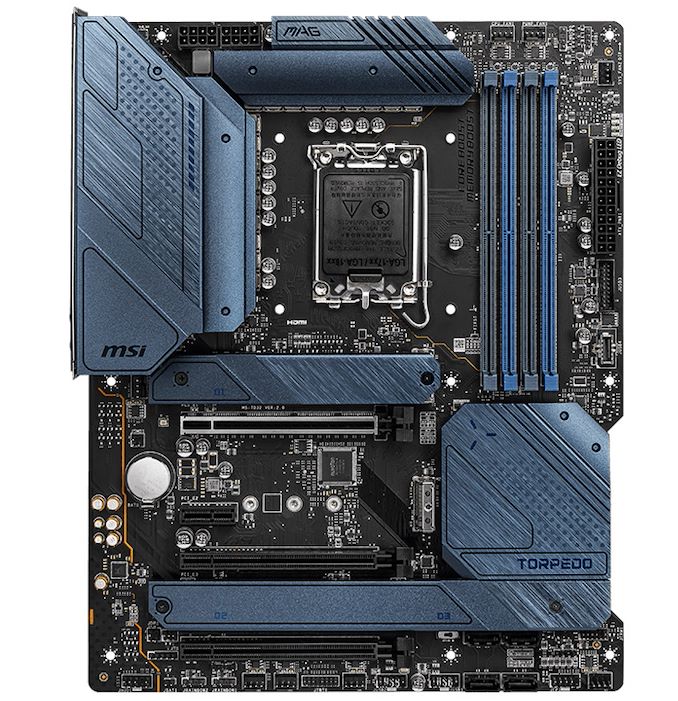The Intel Z690 Motherboard Overview (DDR5): Over 50+ New Models
by Gavin Bonshor on November 9, 2021 9:00 AM ESTMSI MAG Z690 Torpedo (DDR5) & Torpedo EK X (DDR5)
The MSI MAG Z690 Torpedo is a slightly cut-down version of the MAG Z690 Tomahawk WIFI, but with a slightly more affordable feature set and a futuristic styled deep bluey-grey aesthetic. Touching more on the aesthetic, all of the board's design includes a metallic grey and blue set of heatsinks, with alternating black and blue memory slots, and an all-black PCB. MSI is advertising an 18-phase power delivery operating at 16+1+1.
Diving into the specifications of the MAG Z690 Torpedo, MSI includes one full-length PCIe 5.0 x16 slot, with two full-length PCIe 3.0 slots operating at x4/x1, with a one smaller PCIe 3.0 x1 slot. Looking at storage options, there's a total of four M.2 slots, including three PCIe 4.0 x4 and one PCIe 3.0 x4 M.2 slot. Other options include six SATA ports with support for RAID 0, 1, 5, and 10 arrays. In the top right-hand corner are four memory slots that are capable of supporting DDR5-6400, with a combined capacity of 128 GB.
On the rear panel is one USB 3.2 G2x2 Type-C, three USB 3.2 G2 Type-A, two USB 3.2 G1 Type-A, and two USB 2.0 ports. One of the USB 2.0 ports supports BIOS Flashback for which there is a small button, while five 3.5 mm audio jacks and S/PDIF optical output are powered by a Realtek ALC4080 HD audio codec. The Torpedo doesn't include a wireless CNVi, but it does include an Intel I225-V 2.5 GbE controller. Finishing the rear panel is a pair of video outputs, including one DisplayPort 1.4 and one HDMI 2.1 output.
The MSI MAG Z690 Torpedo EK X addition is essentially the same as the Torpedo, except it comes with a custom EKWB monoblock, although we don't have any images or other information at the time of writing.












126 Comments
View All Comments
Duwelon - Tuesday, November 9, 2021 - link
Asus' prices are completely bananas. If I build a new rig with Z690 it'll probably be my first non-Asus build in a very long time.Sivar - Tuesday, November 9, 2021 - link
That caught my eye, too. I bought an Asus Hero-branded board for my current system last year at approximately $200 USD.I suspect Asus is shifting their marketspeak because the word "Maximus" (used for the z690 board but not mine) usually applies to their most expensive boards.
blppt - Tuesday, November 9, 2021 - link
This. $2000 for a consumer grade motherboard? WTF are they smoking?Also, I'm pretty sure ASUS will be releasing some TUF Z690s at some point, probably at a lower price point than the primes. My experience with the TUF series has been very positive for the price.
DigitalFreak - Tuesday, November 9, 2021 - link
They know they're not going to sell many of those. Those boards are either for LN2 e-peen competitions or people with more money than sense.Wrs - Wednesday, November 10, 2021 - link
TUF is historically just a bit more expensive than Prime. They already have a TUF DDR4 version - ordered the Wifi one for $290 the other day. If worried about price DDR5 is the first mistake.blppt - Wednesday, November 10, 2021 - link
The X570 TUF was cheaper than the X570 Prime when I went shopping for an AMD board.COtech - Tuesday, November 9, 2021 - link
Subtitle - "Intel Z690 Chipset: Like Z590, But Now With Native PCIe 4.0"I think "But Now With Native PCIe 5.0" is intended.
gavbon - Thursday, November 18, 2021 - link
The Z690 chipset doesn't have PCIe 5.0, this comes from the CPU. The Z690 chipset does, however, now include PCIe 4.0 lanes, whereas Z590 did not.Someguyperson - Tuesday, November 9, 2021 - link
I don't get the "DP IN" ports on the ASUS ProArt Z690 Creator WIFI. I see the author just wrote what was on the ASUS website, but that doesn't really explain anything. Are they passthrough to the Thunderbolt out ports? Is there a capture card built into this motherboard? I'm very confused by the labeling here.uwsalt - Tuesday, November 9, 2021 - link
Those are passthrough to the Thunderbolt port. Add-in Thunderbolt cards work the same way. You slot in your discrete GPU, send the output from both DP ports to the Thunderbolt controller, and then use Thunderbolt to output to a Thunderbolt monitor or hub.